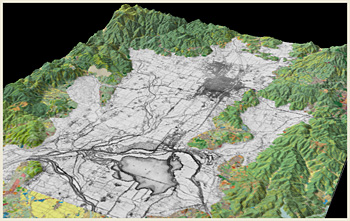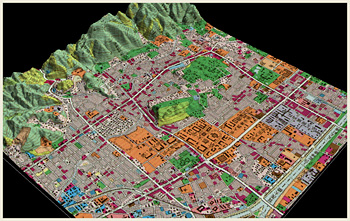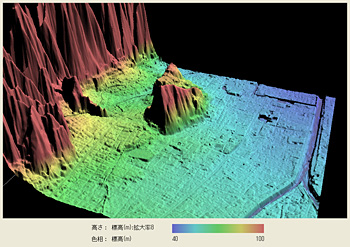Landscapes of the Kyoto Basin — Displays using mapRaster2
Noboru Ogata
Kyoto, the ancient capital of Japan where our university is located, is in a basin surrounded by mountains in three directions except the south. In this page we show bird's eye images created from digital elevation data (DEM) with other geographical sources using mapRaster2.
 Satellite
Imagery (Landsat 7 ETM+: August 25, 2000)
Satellite
Imagery (Landsat 7 ETM+: August 25, 2000)
Earth observation satellite imagery of LANDSAT 7 is draped over the surface
model. The satellite data was received by JAXA
Japan and distributed by RESTEC
Japan.
Land use maps published by the Geographical
Survey
Institute of Japan in the 1980's are draped over the surface model. Different
categories of land uses are shown in colors. Although the sources maps are somewhat
old, we can see that industrial areas shown in blue are mainly located in the
western and southern part of the city of Kyoto.
 Kyoto
in the late 19th century
Kyoto
in the late 19th century
Maps created by the Japanese army around 1890 are draped over the
surface model (only for the flat areas). Those maps are among the
first works utilizing
modern cartography. The image reflects pre-modern situation of the
city of
Kyoto. It also
shows the remaining structure of the Heian-kyo (ancient Kyoto) built
as the capital of Japan late in the eighth century.
 The
neighborhood of Kyoto University
The
neighborhood of Kyoto University
Using high resolution (5 meters) digital elevation data, this image shows
the neighborhood of our university in the northeastern part of Kyoto.
Land use map is draped over the surface model, and the category of
educational institute is shown in orange. Tourist spots such as Heian
Shrine and Ginkakuji Temple are also in this area.
 Geomorphologic
analysis of the neighborhood of Kyoto University
Geomorphologic
analysis of the neighborhood of Kyoto University
The Kyoto Basin is made of alluvial fans formed by many streams flowing
from the surrounding mountains. By exaggerating the elevation by eight-fold
and colored by elevation, we can see two major alluvial fans (shown
in yellow) in the area. The larger one on this side, where our university
is located, is the fan deposited by Shirakawa River. We can also find
an active fault running through the area.
![]()